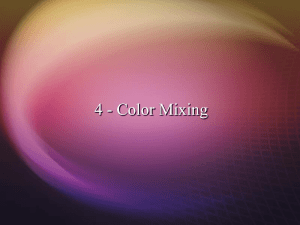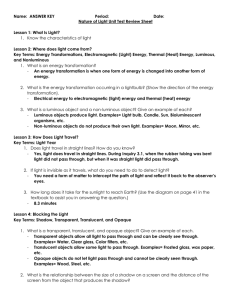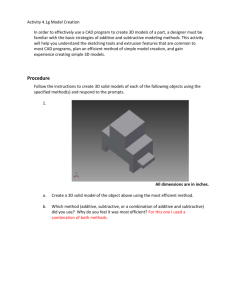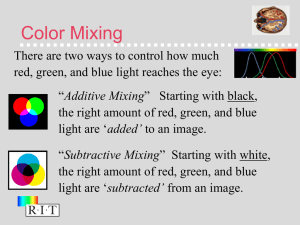Additive and Subtractive Mixing
advertisement
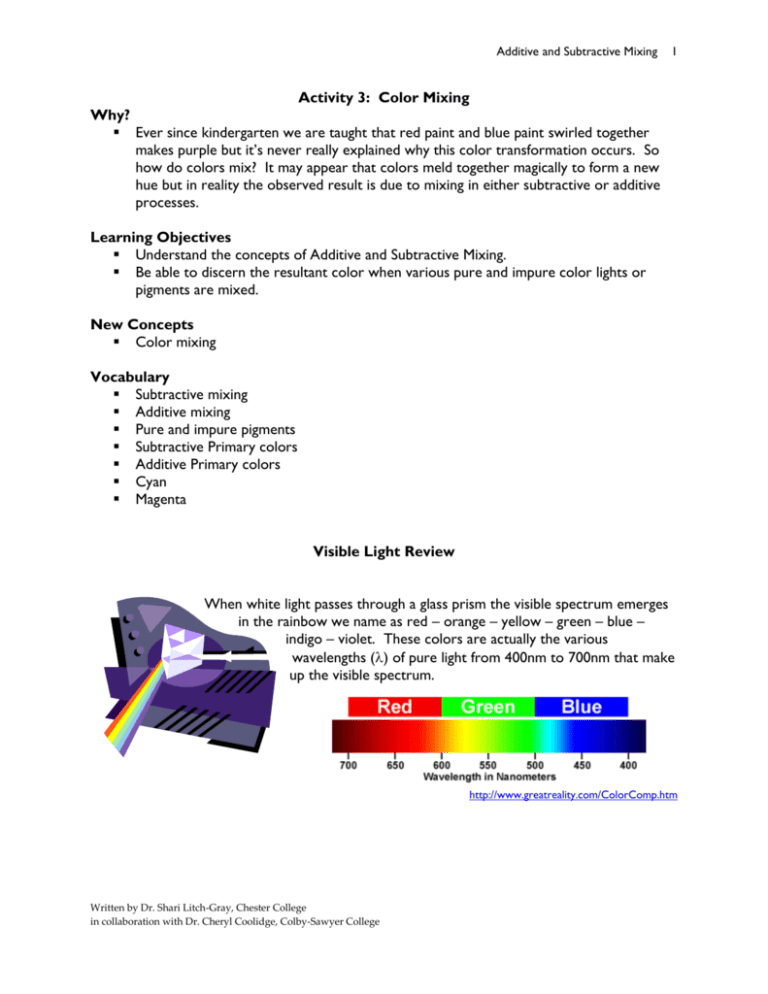
Additive and Subtractive Mixing 1 Activity 3: Color Mixing Why? Ever since kindergarten we are taught that red paint and blue paint swirled together makes purple but it’s never really explained why this color transformation occurs. So how do colors mix? It may appear that colors meld together magically to form a new hue but in reality the observed result is due to mixing in either subtractive or additive processes. Learning Objectives Understand the concepts of Additive and Subtractive Mixing. Be able to discern the resultant color when various pure and impure color lights or pigments are mixed. New Concepts Color mixing Vocabulary Subtractive mixing Additive mixing Pure and impure pigments Subtractive Primary colors Additive Primary colors Cyan Magenta Visible Light Review When white light passes through a glass prism the visible spectrum emerges in the rainbow we name as red – orange – yellow – green – blue – indigo – violet. These colors are actually the various wavelengths () of pure light from 400nm to 700nm that make up the visible spectrum. http://www.greatreality.com/ColorComp.htm Written by Dr. Shari Litch-Gray, Chester College in collaboration with Dr. Cheryl Coolidge, Colby-Sawyer College Additive and Subtractive Mixing 2 When white light enters a material the color perceived is the result of the material absorbing all visible except for the apparent color which is reflected. For example, when light strikes a piece of red paper, the chemical constituents of the paper absorb the shorter corresponding to green and blue and transmit or release the longer , those corresponding to red. For each pure spectral color, a reflectance curve indicates when light is released or bounced off of a material. www.sabic-ip.com Why is fluorescent light often considered to have a “cool” hue? www.candle-web.co.uk So, what occurs when the illuminated material (as is the case for most paints, inks and dyes) is not spectrally pure? How is the viewed color being generated? It is often assumed that pigment colors are adding together to make a new hue when actually the reverse, subtraction, is the case. Subtractive Color Mixing Subtractive Mixing is a method of generating color occurs when white light enters a solid medium. Depending on the chemical nature of the material, certain of light will be absorbed (ie. “subtracted” or removed from consideration). The remaining are refracted (bent) and reflected yielding the color perceived. The components in a colored material are not usually “pure” meaning that they absorb all but one of light. Therefore colored materials are “impure” meaning the range transmitted covers several of the colors of the rainbow resulting in a mixture. If a paint is made of blue and yellow pigments, what colors are absorbed? What colors are reflected? Written by Dr. Shari Litch-Gray, Chester College in collaboration with Dr. Cheryl Coolidge, Colby-Sawyer College Additive and Subtractive Mixing Primary pigments are those three colors that when combined produce black (ie. all light is absorbed). The primary pigments in Subtractive Mixing are as follows: Yellow Cyan – “blue-green” Magenta – “red-blue” www.horrorseek.com Complete the column in the table below with the correct color of light for the Absorbed. Primary Subtractive Color Yellow Cyan Magenta Reflected Absorbed Apparent Color Red , Green Blue, Green Red, Blue Activity Using provided white paper discs and colored paint provided, paint one disc blue and one disc yellow. Set these aside. In a palette with indentations, mix some of the blue and yellow together. Take one additional white disc and paint it with the result of the mixing. Explain the results of painting all three of the discs in the table below: Disc number Color Observed Explanation (colors absorbed) 1 2 3 Written by Dr. Shari Litch-Gray, Chester College in collaboration with Dr. Cheryl Coolidge, Colby-Sawyer College 3 Additive and Subtractive Mixing 4 Additive Color Mixing The making of color with light as the medium follows a different pathway called Additive Color Mixing. When examining the process of coloration by an additive method, the medium involved is wavelengths () of transmitted light superimposed on one another such that the colors combine or “add” together to make a new or new color. Primary pigments are those three colors that when combined produce white light. The primary pigments in Additive Mixing are as follows: Red Blue Green www.horrorseek.com A demonstration of Additive Mixing would occur if beams of colored light were shined upon a white wall. If the beams were shined adjacent to one another their separate colors would be seen. If the beams are subsequently superimposed, the original colors would “add” and a new color would appear. Activity Gather 3 students/group and using flashlights with colored gel covers (red, green & blue), follow the procedure below. 1. The first student projects the red light onto a white wall. 2. The second student separately projects blue light and then the third student projects green. 3. Lastly, have each student overlap their light source with ⅓rd of the others. What color is at the center? Why? Written by Dr. Shari Litch-Gray, Chester College in collaboration with Dr. Cheryl Coolidge, Colby-Sawyer College Additive and Subtractive Mixing 5 For each primary color a complementary color exists which when combined with the primary results in grey, black or white. The complementary color results for Additive & Subtractive Mixing are shown below: Colors Yielded Additive Mixing (ie. lights) Subtractive Mixing (ie. pigments) Red -------------- Cyan white black/grey Blue -------------- Yellow white black/grey Magenta white black/grey Green -------------- http://www.greatreality.com/ColorComp.htm For generating Subtractive Colors through the use of pigments or inks, any color can be produced by mixing correctly proportioned amounts of cyan, yellow and magenta EXCEPT for a true black. In this case a true black pigment must be added as the mixing of cyan, yellow and magenta often yields a muddled black. The CMYK color printing model utilizes cyan, magenta, yellow and black inks instead of mixing the first three to remove all light hence make black. This method is called 4-color printing and is more appealing visually by producing a true black. Written by Dr. Shari Litch-Gray, Chester College in collaboration with Dr. Cheryl Coolidge, Colby-Sawyer College Additive and Subtractive Mixing The following illustration demonstrates the production of color by both the Additive and Subtractive Mixing methods. www.quickstep.com Activity Using the supplied paints and colored filters on flashlights, demonstrate each of the following examples and complete the table below: Mix Resultant Color Red paint + Blue paint Green light + Blue light Red light + Blue light Magenta paint + Yellow paint Magenta + Cyan + Yellow paints Red + Blue + Green lights DONE! Written by Dr. Shari Litch-Gray, Chester College in collaboration with Dr. Cheryl Coolidge, Colby-Sawyer College Additive or Subtractive? 6
